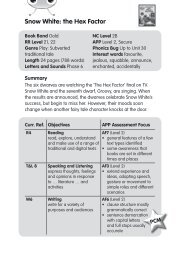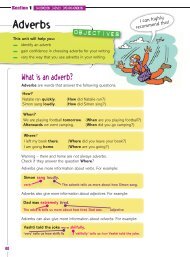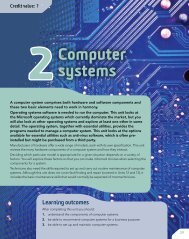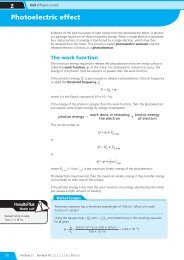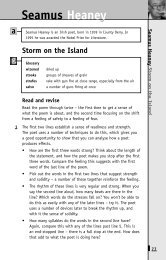Energy and our Universe - Pearson Schools
Energy and our Universe - Pearson Schools
Energy and our Universe - Pearson Schools
You also want an ePaper? Increase the reach of your titles
YUMPU automatically turns print PDFs into web optimized ePapers that Google loves.
52<br />
BTEC’s own res<strong>our</strong>ces<br />
2.8 Underst<strong>and</strong>ing radiation<br />
In this section:<br />
Key terms<br />
P4<br />
M2<br />
Nucleus – the inner part of the atom,<br />
where protons <strong>and</strong> neutrons are found.<br />
Radiation – energy spreading out, as<br />
carried by electromagnetic radiation, or<br />
carried by a particle.<br />
Ionising radiation – radiation that can<br />
remove electrons from atoms, causing<br />
the atom to become positively charged.<br />
Non-ionising radiation – radiation that<br />
does not remove electrons from atoms,<br />
e.g. microwaves or infrared.<br />
When we think of radiation, we<br />
usually think of things like nuclear<br />
bombs <strong>and</strong> radiation leaks,<br />
which are uncontrolled radiation<br />
<strong>and</strong> are extremely dangerous.<br />
However, medical physicists can<br />
use controlled radiation to kill<br />
cancer cells in tum<strong>our</strong>s.<br />
D2<br />
A stable nucleus has the right number of protons <strong>and</strong> neutrons so it<br />
does not break apart. If the number of protons <strong>and</strong> neutrons changes,<br />
the nucleus becomes unstable <strong>and</strong> emits ionising radiation. This<br />
radiation has three types: alpha, beta <strong>and</strong> gamma. They differ in how<br />
ionising <strong>and</strong> how penetrating they are, <strong>and</strong> how they react to magnetic<br />
or electrical fi elds.<br />
Non-ionising radiation is radiation from the low frequency end of the<br />
electromagnetic spectrum: radio, microwave, infrared <strong>and</strong> visible light.<br />
Alpha () radiation<br />
Alpha radiation consists of particles. These are helium nuclei, each<br />
having two protons <strong>and</strong> two neutrons, <strong>and</strong> a charge of +2. When <br />
particles hit another substance, e.g. air, they knock electrons off the<br />
particles they hit. This leaves the particles with a positive charge; the<br />
particles have been ionised. Alpha radiation is highly ionising. (If you<br />
swallow particles, they cause serious damage because they ionise<br />
DNA.)<br />
particles are large compared with electrons <strong>and</strong> protons so they<br />
cannot penetrate far into a material. For example, a few centimetres<br />
of air or a sheet of paper will stop particles. particles are weakly<br />
penetrating. This means there is little chance of particles getting<br />
into the human body through the skin.<br />
Because particles have a positive charge, they will be attracted to a<br />
negatively charged plate.<br />
Activity A<br />
Describe alpha radiation.<br />
Beta () radiation<br />
Beta radiation consists of fast-moving electrons that have been given off<br />
(emitted) by unstable nuclei. If they collide with an atom, they can knock<br />
off an electron <strong>and</strong> ionise the atom. Because particles are small, they<br />
don’t ionise as much as particles. They are moderately ionising.<br />
Because they are less strongly ionising, particles can travel<br />
further than particles. They can travel through a few millimetres<br />
of aluminium before they are stopped. They are moderately<br />
penetrating. This makes them dangerous if they come into contact<br />
with living things.<br />
Because particles are electrons, which have a negative charge,<br />
they will be attracted to a positively charged metal plate. They are<br />
defl ected more than particles because they are lighter.



